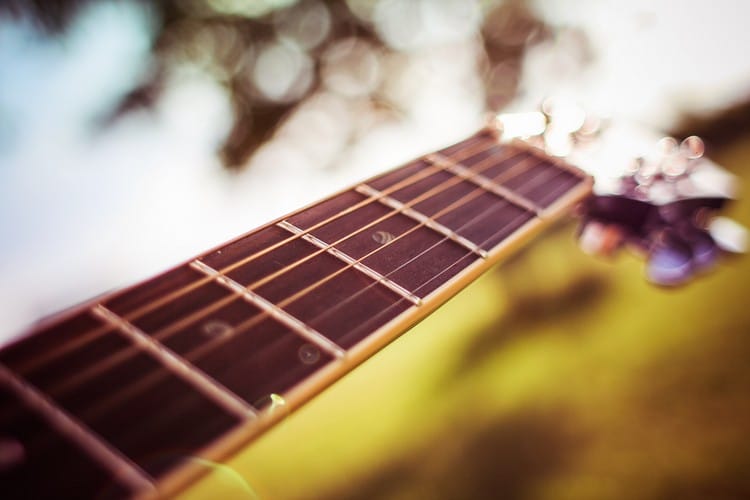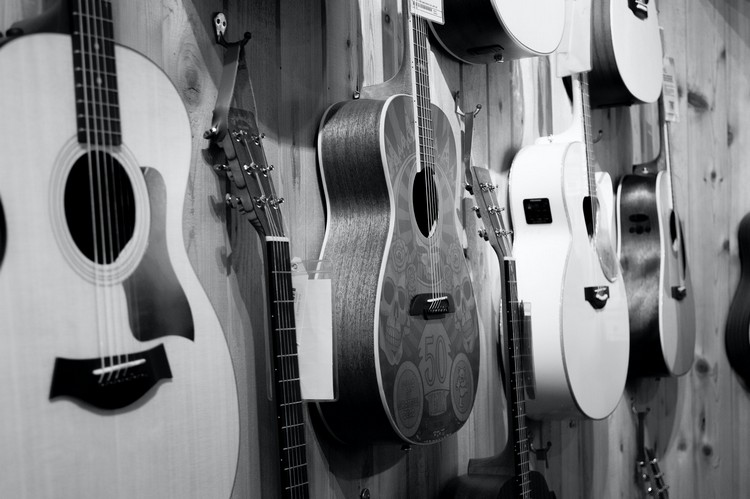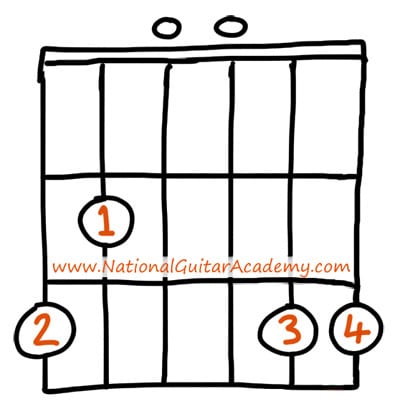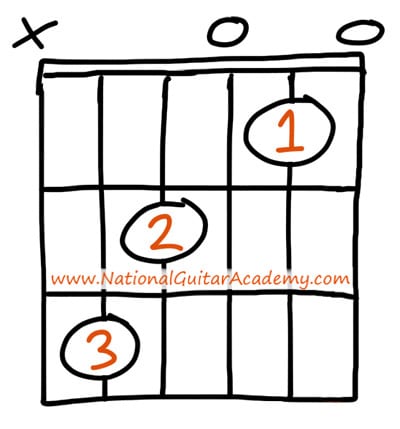Although there are a variety of ways to approach guitar playing and guitar fingerings, there are certain ways that can make life a lot easier – let’s explore them!
Over 250,000 guitar-learners get our world-class guitar tips & tutorials sent straight to their inbox: Click here to join them
In this free lesson you will learn…
- How to approach guitar fingerings in chord diagrams
- Optimal positioning for learning tablature in an effective, pattern-based way
- The secret behind non-linear patterns & how to make them less intimidating
- The secret to developing confidence in your guitar playing!
Let’s Learn To Understand Guitar Fingerings!
If you’re a beginner guitarist, chances are you’ve set your eyes on some chord diagrams and tablature already.
Chances are, you probably don’t yet understand what it is you’re looking at or how to organize your fret hand to approach them.
First off – that’s ok! We all start somewhere, and you’re definitely in the right place to learn to understand everything.
When it comes to playing guitar, we need to start off by organizing our fingers numerically in order to understand the best way to approach guitar fingerings.
In this lesson, you’re going to learn everything you need to approach tablature, chord diagrams and the guitar itself with confidence.

Much like piano, the guitar is an instrument based around patterns that get easier to play the more organized you are with your fingers.
Whether you’re playing chords or melodies (or both), your guitar fingerings should be such that they make it easy for you to move around the fretboard.
Pro Tip: It’s easier than you think to “get in your own way” on the fretboard when you’re starting out.
Learning to move around the fretboard in four-fret patterns helps us immensely – and that’s part of what we’re going to talk about today.
But first…

What Do We Mean By Guitar Fingerings?
This phrase refers to how you approach the fretboard, chords and patterns.
If we just played chords and melodies any type of way, we wouldn’t be able to build up to playing them faster (or we would and it would just take longer).
There’s a process to playing the guitar, and even though there isn’t a “right way” to play the instrument, there is definitely a way that makes it easier.
Even the most unorthodox of guitar players have a method of approaching the fretboard that keeps their playing concise, accurate and clean.

The first thing we need to do is look at how to organize our fret hand numerically:
1 – Index finger
2 – Middle finger
3 – Ring finger
4 – Pinky finger
When reading chord diagrams, you’ll often notice the fingers on the diagram labelled in this way.
Guitar playing needs to be a fluid and ergonomic thing, so keeping our guitar fingerings organized this way helps make playing easier..
If we’re going to learn about guitar fingerings the right way, we’re going to have to approach this topic in stages.
We’ll start with chord diagrams, then move to tablature and close off by talking about how to use this concept all across the fretboard.
Ready? Grab your guitar and settle in – we’ve got a lot to unpack.

Learn 12 EASY beginner chords with our popular guide

✅ Stop struggling. Start making music.
✅ Learn beginner-friendly versions of every chord.
This is our most popular guide and it will improve your chord ability quickly! 😎
Get your own personalised guitar-learning plan 🎸
Get a custom guitar-learning plan here: Click here for GuitarMetrics™
World-Class Guitar Courses 🌎
Learn from the world's best guitar educators: Click here for our guitar courses
Approaching Guitar Fingerings In Chord Diagrams
Chord diagrams are likely the first place that you’ll openly spot hints at numbering your fingers, and rightfully so – it’s the only way to really understand them if you’re a beginner player.
As we stated above, our fingers are numbered 1 through 4, with 1 being our index finger and 4 being the pinky.
With this in mind, we can use this principle to shape where and how we position our fingers.
Let’s start with the example of a G major chord.
Check out the guitar fingerings for this chord below:
G MAJOR
High E string: Pinky finger
B string: Ring finger
G string: Open
D string: Open
A string: Index finger
Low E string: Middle finger
As a beginner (or as any level of guitarist, really), we need a practical and easy way to play this chord that helps us avoid cramping our hand.
We also need a way that gives us the ability to move into another chord with ease when we want to, and that’s what this finger positioning does (even if it doesn’t feel like it at first).
Pro Tip: The right guitar fingerings will always promote further movement across the fretboard. If you’re organized with your fingers, you won’t find yourself getting “stuck” nearly as often.
For more on how to learn the G major chord, click here for a free video lesson.

A Second Example of Guitar Fingerings in Chord Diagrams
Another super-easy example to help you work on mapping your fingers across multiple frets is the C major chord.
What makes this chord easy is the way in which your fingers are laid out across the first three frets.
Your ring finger extends the furthest out to the third fret on the A string, and everything else is just a matter of working backwards.
The guitar fingerings for the C major chord are as follows:
High E string: Open
B string: Index finger
G string: Open
D string: Middle finger
A string: Ring finger
Low E string: Mute
C MAJOR
“But why can’t I play different guitar fingerings with these chords? There’s got to be multiple ways to play a chord, no?”
There are, but don’t forget – there’s an easy way and a hard way for everything.
As you progress further on with guitar, you’ll learn new ways of approaching chords. In the meantime, focus on the ones that are the easiest on your hands and make the most sense.
Want a bit more info on approaching the C major chord, and a few easy-to-play beginner variations? Click here for a video lesson. It’s on the house.
Now that we’ve worked out how to approach guitar fingerings with chord diagrams, let’s move on to topic number 2:
Tablature.
Note: If you haven’t started reading tablature yet and are worried about moving forward with this lesson, click here for a lesson on reading tablature for beginners.
Guitar Fingerings & Tablature
Much like chord diagrams, playing along to tablature requires that you set yourself up for success in the way you approach the fretboard.
This is especially true as you move forward learning melodies and guitar lines that span further across the fretboard.
In order to understand guitar fingerings a bit easier, we’ve included a little guitar line you may have heard of:
The chromatic scale.
Pro Tip: To really get the gist of this lesson, we highly recommend you play through this tab before moving forward.

“Why do I need to play this? There’s no melody to it! It sounds like nothing!”
That’s kind of the point! The chromatic scale doesn’t have any sense of movement or melody like the major or minor scales.
We use this scale as a means of improving our dexterity as beginners and organizing our guitar fingerings for fluid movement.
By simply playing these “1-2-3-4” patterns on guitar, we begin to teach our fingers how to move in sequence.
This is a huge hack for moving your sense of dexterity forward on the guitar, and for learning to attack notes with a bit more confidence also.
Now, let’s tighten up those guitar fingerings by playing that line in reverse.

Pro Tip: These aren’t lines that you play one time and forget about. It’s worth revisiting the chromatic scale often as a beginner to focus on building confidence in your fingers, which will lead to easier playability in the long run.

Guitar Fingerings & Tablature II: Non-Linear Playing
Not every line of music takes place on the same set of strings, and so it’s important to practice our playing in a variety of different ways to develop confidence in our approach to the instrument.
This is where practising scales comes in super handy.
Musical scales don’t just occur on every fret in sequence – they occur on select frets in specific intervals.
This is great for us as beginner guitarists, because we can use this as an opportunity to develop independence in each finger where our guitar fingerings are concerned.
Let’s take a look at this C major scale shape. Take your time and play through it before you move on.

This scale is different from the chromatic scale in just about every way, but most importantly in that it doesn’t use every available note.
This means we get the chance to work on each finger individually and not just all of them in sequence.
Pro Tip: When it comes to really working on your guitar fingerings, you should focus intently on playing scales like this one and the chromatic scale.
Although they seem relatively boring on the outside, you’re doing your ears and your hands a huge service by taking the time to play these scales.
Over time, you’ll start to be able to hear intervals more accurately, making it easy for you to find the notes you want when playing guitar.

Download our lead guitar cheat-sheet to make things easier
It's hard to understand which scales work with which keys.
So we created a cheat-sheet! A key and scale-finder that you can use again and again.

Get your personalised guitar-learning plan 🎸
Get a custom guitar-learning plan here: Click here for GuitarMetrics™
World-Class Guitar Courses 🌎
Learn from the world's best guitar educators: Click here for our guitar courses
Learning Guitar Fingerings Across The Fretboard
So we’ve covered fixed-position playing quite extensively, but what about when we have to move positions on the fretboard?
What happens then?
It’s quite simple, really: When one finger moves, the whole hand moves anyway.
Wherever that finger lands in its next position, that becomes your home base (until of course, you switch positions again.)
This is hands-down the easiest way to manage yourself across the fretboard.
If you’re playing a chromatic scale like the one above and you reach the end at the high E string, move forward two frets and descend on frets 6-5-4-3 on each string in that order.
See what happened? Your home base moved, and your guitar fingerings moved with it.

This is the beauty of using all four fingers to play guitar – we can cover a fair amount of ground without stretching our hand very much.
Can we cover more ground with advanced guitar fingerings? Absolutely, but don’t focus on that just yet.
The most important part of this lesson is developing confidence in the way we approach notes across the strings – either in groups like we do with chords, or one at a time like we often see in tablature.
Mastering these two principles will give you an extremely solid foundation to work off of when it comes to learning guitar in the future.

Other Non-Linear Fingerings
Before we wrap things up, there was one more little tidbit of knowledge from the chromatic scale that we thought you’d enjoy learning how to play.
This is a super-awesome way to mix things up and further develop better finger independence with a variety of different guitar fingerings that will reinforce everything we’ve talked about today thus far.
We’re putting this one in because we know some of you out there are real go-getters who want to take your guitar playing as far as possible – we see you, and we commend you.
If you thought the chromatic scale’s 1-2-3-4 patterns were a bit bland, scroll down for a bonus challenge before we sign off.

The 1-2-3-4 pattern of the chromatic scale is great, but it only promotes so much finger independence and it sounds a bit bland, if we’re being honest.
We can mix up this pattern rather easily. We’ve included eight bonus patterns for you to play that will help you work on your guitar fingerings in a huge way.
Check them out below:
- 1 – 3 – 2 – 4
- 1 – 4 – 2 – 3
- 1 – 4 – 3 – 2
- 2 – 1 – 3 – 4
- 1 – 2 – 4 – 3
- 2 – 1 – 4 – 3
- 3 – 2 – 1 – 4
- 3 – 1 – 2 – 4
These are just a few of the combinations you can make from the chromatic scale in the first position, but we encourage you to explore the fretboard in different ways and come up with your own patterns, too!

How To Improve Your Guitar Fingerings Even Further
Practice is endless when it comes to music – we all know that.
However, there are a number of things you can do to push yourself forward that little extra bit when working on your guitar fingerings:
- Practice finger independence in both linear & non-linear ways (ex. 1-2-3-4 and 2-1-4-3)
- Work on chord shapes as often as you can and practice keeping open strings ringing as clear as you can
- Don’t get frustrated! Complete independence in your guitar fingerings takes time and practice. Remember that every day is a chance to push yourself forward just a bit more.
Recommended Resources
If you enjoyed and benefited from this lesson on guitar fingerings, you’ll love some of the other free lessons we’ve got on our website.
- How To Read Guitar Tabs
- Guitar Chord Chart
- How To Play The Major Scale
- How To Teach Yourself Guitar In 10 Easy Steps
- Guitar Scales Chart
What Type of Guitarist Are You?
Take our 60-second quiz & get your results: Take The Quiz
Join the world's best online guitar school 🌎
- Get your own personalised guitar learning plan (customised just for YOU).
- World-class online guitar courses. Learn at your own pace.
- Community Campus & Learning Forum - A friendly community! Connect with our team & students. 😊
- Beginner Song library with chordsheets, tabs and tips. (Songs suitable for all levels!)
- Regular live streams, seminars and Q&A sessions - Learn from world-class guitar educators. Get all your questions answered!
Click here to learn more about National Guitar Academy membership 
Cool Guitar T-shirts 😎
Look cooler! Check out our merch: Click here to see our merch store
Want free guitar tips and video lessons delivered to your inbox?
Join over 250,000 other guitar learners and subscribe to our guitar-tips-by-email service. (It's free.)
We'll send you a series of lessons that will move you to the next level of your guitar journey.
Learn how everything fits together quickly, easily and effectively. We share ninja tips (for instant fun!) but also timeless fundamentals that will deepen your understanding.

Popular Lessons
How To Learn Guitar: An 11-Step Programme For Beginners
How To Choose The Perfect Beginner Guitar
More Cool Guitar Stuff
Learn about National Guitar Academy: About Us
Visit our YouTube channel for fun guitar videos.
Join us on Facebook for daily guitar tips.
Listen to our Learn Guitar Podcast for rapid guitar progress.
Check out our free chord lessons.
Get our best guitar tips & videos
Where should we send it?
Where should we send it?
Get our best guitar tips & videos





